“Our changing seas” – SAMSS 2008
|
- By Dr Kim Bernard, Coastal Science and Data Coordinator, SAEON Elwandle Node & Penny Price, Scientific and Support Officer, SAEON Egagasini Node
Several SAEON staff members attended the 13th Southern African Marine Science Symposium (SAMSS).
SAMSS was hosted by the Western Cape representatives of the South African Network for Coastal and Oceanic Research (SANCOR) at the University of Cape Town.
Held every three years, SAMSS is a symposium series that began in Durban in 1970 with a gathering of 54 of South Africa’s professional marine scientists. This year, it drew nearly 400 marine scientists.
SAEON was represented by both of its marine nodes, Elwandle and Egagasini, with staff and students from the nodes presenting a variety of talks and posters related to this year’s very topical theme, ‘Our changing seas’.
Due to the positive response the conference received from the marine science community, three parallel sessions were held each day with various topics under discussion in each session.
Sessions included Marine Protected Areas; Estuaries; Coastal Impacts; Fisheries Stock Assessment and Management; Southern Ocean; Food Web Variability; Intertidal and Nearshore Ecology; Studies off the West Coast (chaired by Dr Juliet Hermes, Manager of the SAEON Egagasini Node); Marine Education and Communication; and many more.
Monitoring systems and networks
The session ‘Monitoring Systems and Networks’ was put forward by SAEON, who invited guest speakers such as Dr Marten Grundlingh, Manager of the South African Data Centre for Oceanography (SADCO) and Prof Geoff Brundrit, Chair of Global Ocean Observing Systems in Africa (GOOS Africa). Both these talks were highly informative and dealt with network opportunities, links to existing data repositories and real-time data within the marine sector.
On the morning of the first day of the conference, Nicola James from the Elwandle Node presented the results of her PhD thesis in the ‘Temporarily Open/Closed Estuaries’ session. Her talk dealt with the recruitment patterns of Cape stumpnose and white steenbras in the East Kleinemonde Estuary in the Eastern Cape.
Posters were presented each day during lunch time, and on Monday Sean Bailey and Dr Angus Paterson of the Elwandle Node presented their poster entitled ‘Long-term variation in the demersal fish communities of selected Eastern Cape estuaries’.
SAEON representation continued after lunch when Dr Albrecht Götz and Russell Chalmers from the SAEON Graduate Student Network (Rhodes University) presented talks in the ‘Marine Protected Areas’ session. Albrecht presented his research undertaken in the Tsitsikamma National Park marine protected area, and Russell presented results from his PhD thesis in the Greater Addo National Park marine protected area.
On Tuesday, Dr Kim Bernard and Anthony Bernard, both from Elwandle, presented data from their Southern Ocean research in the ‘Southern Ocean’ session, with Kim discussing the impact of ocean acidification on pteropods and Anthony talking about the importance of eddies in enhancing biomass and species diversity north of the Antarctic Polar Front.
In the plenary session entitled ‘Network and Funding Opportunities and Information’, Dr Juliet Hermes gave an informative talk on the two marine SAEON nodes, whereby she highlighted SAEON’s role in marine science in South Africa, through observation, information and education.
With five SAEON posters being presented, the Wednesday lunchtime poster session was dominated by SAEON. Wayne Goschen, of Egagasini, presented a collaborative poster between the two SAEON marine nodes and SAEON National Office, entitled “Towards a data management system for long-term monitoring of the marine systems around Southern Africa”.
Two of Elwandle’s MSc students, Luzuko Dali and Ntuthuko Masikane, presented posters on their research to date, Luzuko’s poster illustrating the spatial dynamics of mesozooplankton in Algoa Bay and Ntuthuko’s poster reporting on a comparative analysis of nearshore macrozoobenthic structure in Algoa Bay. Both students are members of the SAEON Graduate Student Network.
Nicola James’ poster dealt with the influence of the permanently open Sundays Estuary on the nearshore marine environment of Algoa Bay, while Thomas Mtontsi of Egagasini focused on opportunities for school science outreach, illustrating the highlights of a Southern Ocean voyage on board South Africa’s Antarctic supply and research vessel, the SA Agulhas.
The Earth – Not too hot, not too cold
After lunch, proceedings were kicked off with a dynamic performance by the LEAP Science and Maths School entitled ‘The Earth – Not too hot, not too cold’. This performance was scripted by Penny Price of Egagasini, who also co-produced and co-directed it with Mthuthuzeli Gulekana of CSIR/MCM along with the learners themselves.
This theatre piece was created as part of the ACCESS programme of workshops for the Grahamstown Science Festival which took place in March this year. Consisting of African dance, song and drumming, it proved a very successful medium for the communication of Earth science at the Science Festival and was also very well received at SAMMS.
Thereafter, SAEON representation was picked up once more with Raymond Roman, the new Egagasini postdoctoral student, who presented an illuminating talk on Red Sea water in the greater Agulhas Current.
SAEON-related presentations continued with Shaun Deyzel and Angela Mead, both from the SAEON Graduate Student Network (NMMU and UCT respectively), who presented results from their PhD theses in parallel sessions.
In the session entitled ‘Studies off the South and East Coasts’, Shaun discussed the implications of egg dormancy in copepods to ecological interpretations, while in the ‘Intertidal and Nearshore Ecology’ session, Angela illustrated how rocky shore communities in False Bay have changed over time.
SAEON representation continued into the fourth and final day of the proceedings with a presentation by Rhett Bennet of Rhodes University, with Dr Albrecht Götz and Ryan Palmer of Elwandle as co-investigators, on the optimisation of sampling protocols for long-term monitoring of temperate reef fishes in a session on ‘Marine Vertebrate Biology and Ecology’.
Overall the symposium was a huge success, thanks to the local organising committee chaired by Charles Griffiths, the scientific committee chaired by Coleen Moloney, as well as the input from the various sponsors. The high quality of science presented during the four days and the large numbers in attendance, including the many students, is a positive reflection of how marine science in Southern Africa is expanding and growing to meet the global challenges facing us.
Both the Elwandle and Egagasini Nodes of SAEON were well represented; arranging one session, chairing another and presenting a total of ten papers, six posters and one drama performance.
With Elwandle Node being operational for only 18 months and the Egagasini Node for less than a year, this certainly amounts to an impressive contribution to a very successful and enlightening gathering of the best southern Africa has to offer in cutting-edge marine science.
 |
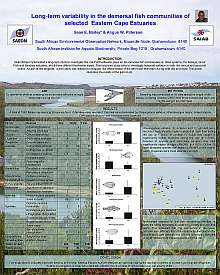 |
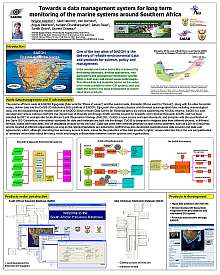 |
| Click to enlarge | Click to enlarge | Click to enlarge |
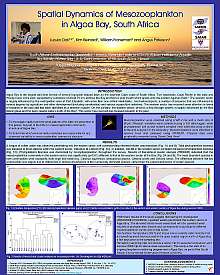 |
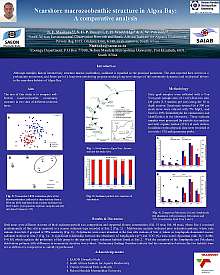 |
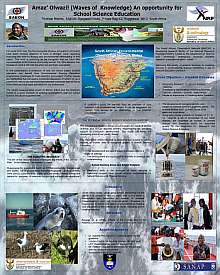 |
| Click to enlarge | Click to enlarge | Click to enlarge |












